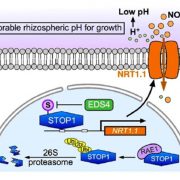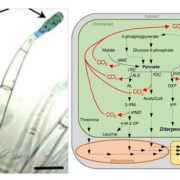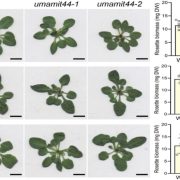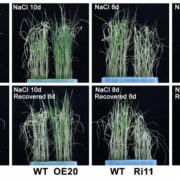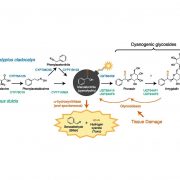A conserved role for flavonoids in the protection of plant tissues from UV damage ($)
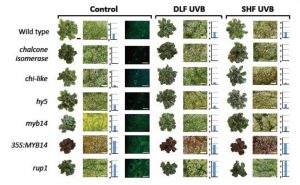 The transition from aquatic to terrestrial environments exposed the earliest land plants to higher doses of damaging ultraviolet (UV-B) radiation. To cope with this stress, land plants evolved complex signalling mechanisms and an inventory of protective ‘sunscreen-like’ flavonoids. To explore whether this paradigm is conserved in extant early divergent land plants, Clayton et al. (2018) investigated the signalling mechanisms induced by UV-B exposure and explored the functional relevance of flavonoid accumulation during UV stress in the model liverwort Marchantia polymorpha. The authors demonstrate that Marchantia employs a UV-B signal transduction cascade similar to that of the model flowering plant Arabidopsis thaliana, through a conserved MpUVR8 UV-B photoreceptor, the transcriptional activator MpHY5 (Elongated Hypocotyl5), and the negative regulator MpRUP1 (Repressor of UV-B Photomorphogenesis1). Moreover, M. polymorpha liverworts exposed to UV-B stress accumulated flavonoids and Marchantia mutants defective in flavonoid production demonstrated increased susceptibility to UV-B damage whereas flavonoid over-accumulation lines (MpMYB14 overexpression) exhibited enhanced tolerance to UV-B. Together these results demonstrate that UV-B signalling modules and flavonoids play a conserved role in UV photoprotection, which suggests that this adaptation likely arose early during the evolution of land plants. (Summary by Phil Carella) Plant J. 10.1111/tpj.14044
The transition from aquatic to terrestrial environments exposed the earliest land plants to higher doses of damaging ultraviolet (UV-B) radiation. To cope with this stress, land plants evolved complex signalling mechanisms and an inventory of protective ‘sunscreen-like’ flavonoids. To explore whether this paradigm is conserved in extant early divergent land plants, Clayton et al. (2018) investigated the signalling mechanisms induced by UV-B exposure and explored the functional relevance of flavonoid accumulation during UV stress in the model liverwort Marchantia polymorpha. The authors demonstrate that Marchantia employs a UV-B signal transduction cascade similar to that of the model flowering plant Arabidopsis thaliana, through a conserved MpUVR8 UV-B photoreceptor, the transcriptional activator MpHY5 (Elongated Hypocotyl5), and the negative regulator MpRUP1 (Repressor of UV-B Photomorphogenesis1). Moreover, M. polymorpha liverworts exposed to UV-B stress accumulated flavonoids and Marchantia mutants defective in flavonoid production demonstrated increased susceptibility to UV-B damage whereas flavonoid over-accumulation lines (MpMYB14 overexpression) exhibited enhanced tolerance to UV-B. Together these results demonstrate that UV-B signalling modules and flavonoids play a conserved role in UV photoprotection, which suggests that this adaptation likely arose early during the evolution of land plants. (Summary by Phil Carella) Plant J. 10.1111/tpj.14044


